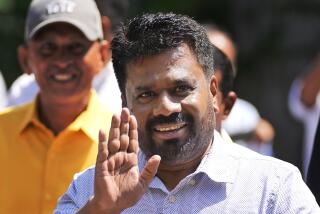Looking to Sri Lanka for lessons
- Share via
NEW DELHI — Sri Lanka’s victory this week after a 25-year battle against the Tamil Tiger rebels represents a rare success story for governments fighting insurgencies.
Even as leaders in Colombo, the capital, declared a national holiday and citizens danced in the streets, military planners and analysts around the world began scrutinizing the war for lessons on how to fight Al Qaeda, the Taliban and other militant groups.
For more than two decades in the conflict in Sri Lanka, neither side was strong enough to overcome the other. That changed three years ago, when the army adopted more mobile tactics, overhauled its intelligence system, promoted young commanders and steadily hemmed in one of the world’s most ruthless and innovative rebel movements.
At its peak, the Liberation Tigers of Tamil Eelam, as the rebels are formally known, controlled one-third of the country, had their own army, a sizable navy and nascent air force, and served as a role model for insurgencies worldwide with their pioneering use of explosives vests and female suicide bombers. This week, the army displayed in triumph what it said was the portly, bullet-riddled body of Tiger leader Velupillai Prabhakaran in his signature fatigues.
What may be the most important factor in ending the stalemate was the political will to do whatever it took. In a supreme irony, President Mahinda Rajapaksa was elected in November 2005 by a 1.9-percentage-point margin after Prabhakaran urged Tamils to boycott the election. Rajapaksa made military victory over the Tigers a cornerstone of his administration and signaled to the military that it could get whatever resources it wanted simply by asking.
“They did everything a general dreams of,” said retired Indian Maj. Gen. Ashok Mehta, a commander of the Indian peacekeeping forces in Sri Lanka in the late 1980s. “Unfettered resources and no political interference.”
The military budget grew by 40% a year, and the army exploded by 70% to 180,000 troops, adding 3,000 a month compared with 3,000 a year previously, drawing largely from rural Singhalese attracted by relatively high wages in a struggling economy.
With more soldiers, the army was able to hit the Tigers on several fronts simultaneously, breaking with years of hit-or-miss operations.
“Before, the army would take territory, then move on, allowing the LTTE to come back,” said military spokesman Brig. Udaya Nanayakkara. “That changed and we hit them on all four fronts so they could no longer muster all their resources into one place.”
Some of the lessons are transferable, experts said.
“Sri Lanka provides a case study,” said Rohan Gunaratna, head of the International Center for Political Violence and Terrorism Research in Singapore.
Other lessons are either unique to Sri Lanka or would be politically unpalatable in other societies, including the high civilian and military death tolls and alleged human rights violations. The United Nations and many human rights groups repeatedly called for a cease-fire so civilians caught in the crossfire could flee the conflict area -- calls the government largely dismissed.
“They were not worried about collateral damage,” said Ajey Lele, an Indian military analyst and ex-wing commander. “So in many regards it’s a very difficult model to adopt.”
By some estimates, nearly 100,000 people died in the war, which began in 1983, including more than 7,000 civilians since January.
Because Rajapaksa’s base was the nation’s Sinhalese majority, there was relatively little domestic pushback over the deaths and displacement of ethnic Tamil civilians. The government restricted the access of international media and independent humanitarian groups, making it difficult to report what was going on.
The lesson of nonstop, no-holds-barred combat -- the army even powered on during monsoons -- was complemented by better use of small, flexible “deep penetration” special forces units, many trained by their U.S. and Indian counterparts. Dressed like the rebels, they went behind enemy lines, assassinating Tigers, crippling infrastructure in rebel-held areas and reporting target locations to the army and air force.
Cutting supply lines, creating faster and more mobile special forces units, going after financing and hitting jungle hide-outs are additional strategies applicable to other insurgency battles, experts said.
At the same time, the Tigers’ scope made them a bigger target. For years, they parked freighters at sea and ferried arms, oil, food and other supplies into ports they controlled.
In recent years, the government destroyed seven of these mother ships, reportedly with the help of satellite intelligence from India and the United States, and made better use of small, maneuverable, heavily armed “Arrow” vessels.
“It adopted many new tactics and techniques,” said retired Indian Col. Ravindra Tripathi, a military analyst. “And it imbued fighting spirit in its troops.”
The broader political climate also was changing, some critics said. Any lingering sympathy for so-called freedom fighters eroded after the Sept. 11 attacks. Though some militant groups, such as the Irish Republican Army, eventually opted for political settlement, Prabhakaran rejected the idea of compromise.
In this new climate, Sri Lanka also gained access to U.S. satellite intelligence and training and benefited from designation of the LTTE as a terrorist organization by the U.S., European Union and India. Smuggling and arms deals, as well as financing from the Tamil diaspora, became more difficult as the international community stepped up its scrutiny of money trails.
“A military precept the world over is that you can’t win militarily against an insurgency, which is essentially a political struggle,” said Maj. Gen. Mehta. “They turned that on its head.”
--
Pavitra Ramaswamy in The Times’ New Delhi Bureau contributed to this report.
More to Read
Sign up for Essential California
The most important California stories and recommendations in your inbox every morning.
You may occasionally receive promotional content from the Los Angeles Times.










